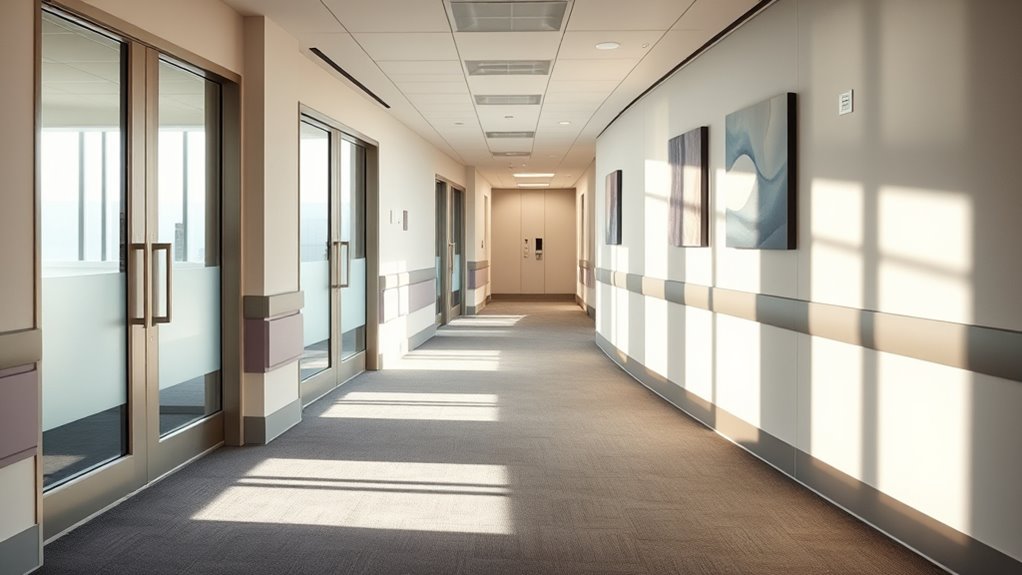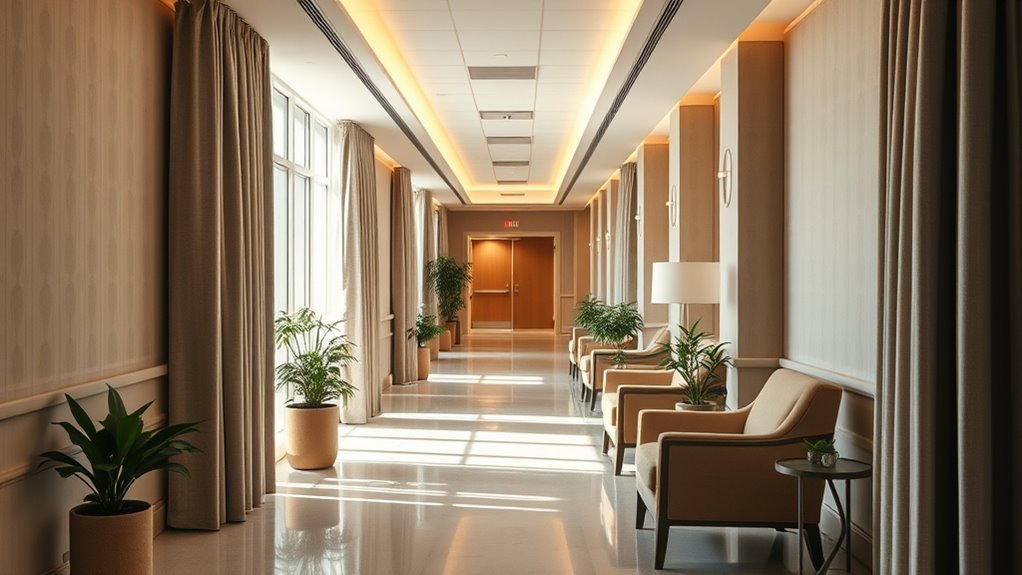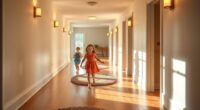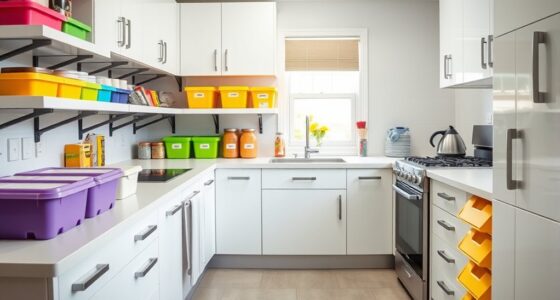To create a soothing, protected environment in your care wing, use soundproofing techniques like insulated walls, special soundproof doors, and cushioned flooring to block noise. Incorporate soft furnishings and acoustic panels to absorb sound and reduce echoes. These strategies work together to minimize disruptions and promote tranquility for residents. By applying these tactics, you can foster a peaceful space that supports well-being. Continue exploring how these solutions can be tailored to your setting.
Key Takeaways
- Use insulated drywall, soundproof panels, and soundproof doors to block noise transmission between rooms.
- Incorporate cushioned flooring like rubber or cork and acoustic ceiling panels to reduce footstep and overhead noise.
- Add soft furnishings, curtains, and upholstered furniture to absorb sound waves and minimize reflections.
- Implement structural barriers and interior design strategies to create a tranquil, stress-reducing environment.
- Combine these soundproofing techniques to promote serenity, safety, and overall well-being for residents.

Have you ever wondered how some care facilities manage to create a calm and soothing environment for their residents? The answer often lies in the design and implementation of a quiet care wing, where soundproofing plays a vital role. This specialized area is carefully crafted to reduce noise levels, offering residents a peaceful space that promotes relaxation and well-being. When you step into a quiet care wing, you’ll notice the absence of loud footsteps, busy conversations, or disruptive sounds that are common elsewhere. This tranquility isn’t accidental; it’s achieved through thoughtful soundproofing tactics that target both structural and interior elements.
First, the walls are constructed with materials that absorb and block sound. You might see thick, insulated drywall or specialized soundproof panels that prevent noise from traveling between rooms and common areas. These materials act as barriers, ensuring that loud noises in one part of the wing don’t disturb residents in their rooms or communal spaces. Doors are also designed with soundproof features, often with seals around the edges that block sound leaks. When you close a door in this wing, you’ll notice how effectively it muffles the outside noise, making each room feel like a private sanctuary.
Walls with soundproof materials create private, peaceful spaces free from noise disruptions.
Flooring choices contribute markedly to sound control as well. Instead of hard surfaces that reflect sound, care facilities often opt for cushioned, resilient flooring materials like rubber or cork. These surfaces not only reduce footstep noise but also add a layer of comfort for residents who may be sensitive to vibrations or sudden sounds. Ceiling treatments can incorporate acoustic tiles or panels that absorb sound from above, further minimizing echoes and creating a cocoon of quietness. When you’re in a quiet care wing, you’ll often notice how sound doesn’t bounce around, allowing conversations and activities to happen without the usual background noise.
In addition to structural strategies, interior design also supports noise reduction. Soft furnishings, curtains, and upholstered furniture help absorb sound waves, preventing them from bouncing around the room. You may see plush carpets and thick drapes that contribute to the overall serenity. Lighting fixtures and technology are carefully selected to avoid creating unnecessary noise, such as buzzing or clicking sounds. All these elements work together to craft an environment where residents can rest, converse, or simply enjoy peace without being disturbed by extraneous noise. Implementing soundproofing techniques can significantly enhance the quality of life in these environments by maintaining the desired tranquility.
Frequently Asked Questions
How Does Soundproofing Impact Indoor Air Quality?
Soundproofing improves indoor air quality by reducing noise-related stress, which can lower your breathing rate and promote relaxation. When you choose proper materials like acoustic panels and guarantee good ventilation, you prevent the buildup of stale air and pollutants. Additionally, soundproofing can prevent the infiltration of outdoor pollutants, helping you breathe cleaner air indoors. Overall, it creates a healthier, calmer environment for you to thrive in.
What Materials Are Most Eco-Friendly for Soundproofing?
You should choose eco-friendly soundproofing materials like recycled cotton or wool, which naturally absorb sound without harmful chemicals. Cork is also an excellent option because it’s sustainable, renewable, and provides good insulation. Green alternatives like cellulose insulation made from recycled paper and plant-based acoustic panels help reduce environmental impact while maintaining effective soundproofing. These materials promote healthier indoor air quality and support sustainability goals in your space.
Can Soundproofing Be Customized for Individual Patient Needs?
Yes, you can customize soundproofing for individual patient needs. You should assess each patient’s sensitivity and specific requirements, then select materials and techniques accordingly. For example, if a patient is highly sensitive to noise, you might add extra insulation or sound-absorbing panels in their room. This tailored approach guarantees a calming environment, helping patients feel more comfortable and secure, promoting faster recovery and better well-being.
How Long Does It Take to Install Soundproofing in a Care Wing?
It typically takes between one to three weeks to install soundproofing in a care wing, depending on the scope and complexity of the project. You’ll need time for planning, acquiring materials, and completing the installation process. Factors like the size of the space, existing infrastructure, and customization requirements can influence the timeline. Working with experienced contractors helps make certain a smooth, efficient installation that minimizes disruption to patient care.
What Maintenance Is Required for Soundproofing Materials?
You might worry maintenance is complicated, but it’s actually straightforward. You should regularly inspect your soundproofing materials for damage, dust, or wear, and clean surfaces with gentle, non-abrasive cleaners. Occasionally, reseal or replace damaged panels to keep their effectiveness. By scheduling routine checks, you guarantee the soundproofing continues to provide a calming environment, protecting residents and staff from disruptive noise and maintaining a peaceful, soothing space.
Conclusion
Imagine walking into the quiet care wing, where gentle whispers drift like soft clouds and every step feels like a calming breeze. The soundproof walls cocoon you from outside noise, creating a sanctuary of serenity. Here, peaceful silence wraps around you like a warm blanket, soothing your mind and protecting your well-being. This haven isn’t just about soundproofing; it’s about cultivating a tranquil space where comfort and care flourish in perfect harmony.









